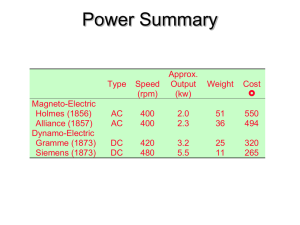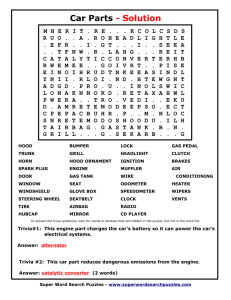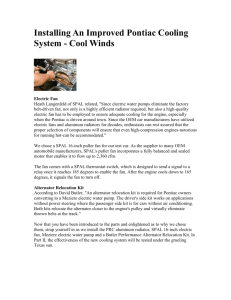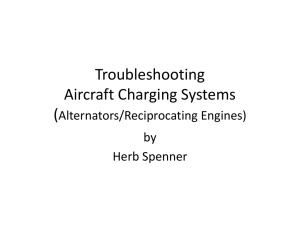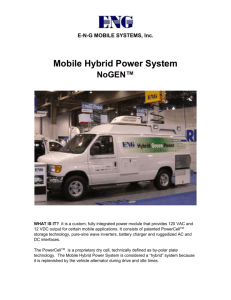Onboard welder using a GM Delco 140 Amp alternator
advertisement
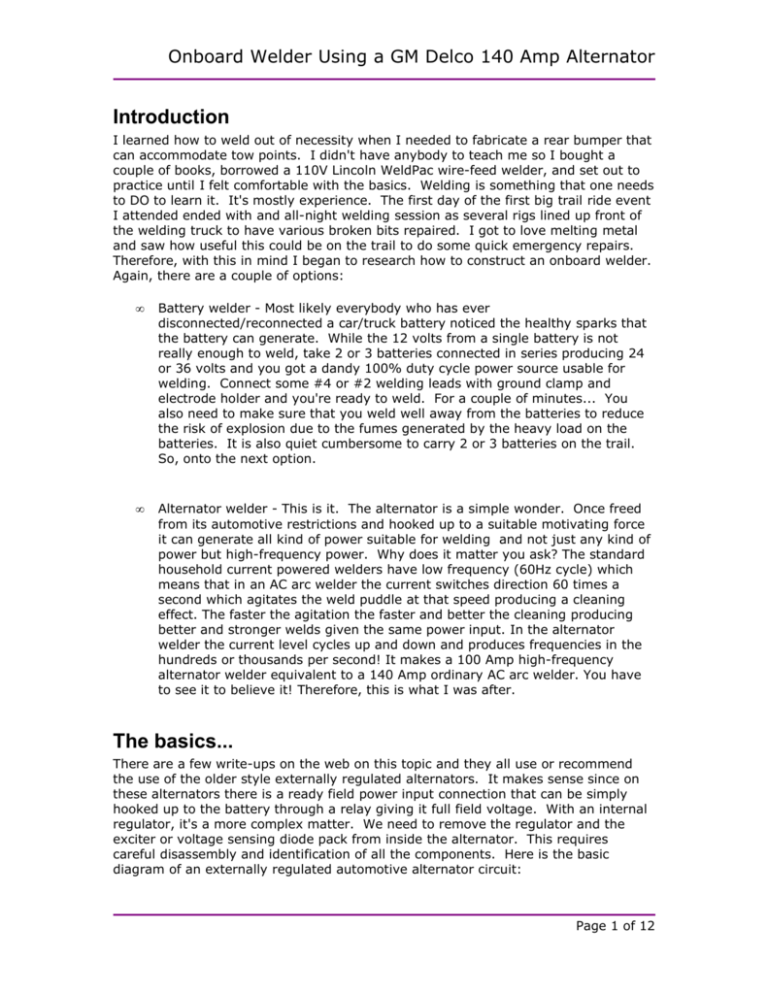
Onboard Welder Using a GM Delco 140 Amp Alternator Introduction I learned how to weld out of necessity when I needed to fabricate a rear bumper that can accommodate tow points. I didn't have anybody to teach me so I bought a couple of books, borrowed a 110V Lincoln WeldPac wire-feed welder, and set out to practice until I felt comfortable with the basics. Welding is something that one needs to DO to learn it. It's mostly experience. The first day of the first big trail ride event I attended ended with and all-night welding session as several rigs lined up front of the welding truck to have various broken bits repaired. I got to love melting metal and saw how useful this could be on the trail to do some quick emergency repairs. Therefore, with this in mind I began to research how to construct an onboard welder. Again, there are a couple of options: • Battery welder - Most likely everybody who has ever disconnected/reconnected a car/truck battery noticed the healthy sparks that the battery can generate. While the 12 volts from a single battery is not really enough to weld, take 2 or 3 batteries connected in series producing 24 or 36 volts and you got a dandy 100% duty cycle power source usable for welding. Connect some #4 or #2 welding leads with ground clamp and electrode holder and you're ready to weld. For a couple of minutes... You also need to make sure that you weld well away from the batteries to reduce the risk of explosion due to the fumes generated by the heavy load on the batteries. It is also quiet cumbersome to carry 2 or 3 batteries on the trail. So, onto the next option. • Alternator welder - This is it. The alternator is a simple wonder. Once freed from its automotive restrictions and hooked up to a suitable motivating force it can generate all kind of power suitable for welding and not just any kind of power but high-frequency power. Why does it matter you ask? The standard household current powered welders have low frequency (60Hz cycle) which means that in an AC arc welder the current switches direction 60 times a second which agitates the weld puddle at that speed producing a cleaning effect. The faster the agitation the faster and better the cleaning producing better and stronger welds given the same power input. In the alternator welder the current level cycles up and down and produces frequencies in the hundreds or thousands per second! It makes a 100 Amp high-frequency alternator welder equivalent to a 140 Amp ordinary AC arc welder. You have to see it to believe it! Therefore, this is what I was after. The basics... There are a few write-ups on the web on this topic and they all use or recommend the use of the older style externally regulated alternators. It makes sense since on these alternators there is a ready field power input connection that can be simply hooked up to the battery through a relay giving it full field voltage. With an internal regulator, it's a more complex matter. We need to remove the regulator and the exciter or voltage sensing diode pack from inside the alternator. This requires careful disassembly and identification of all the components. Here is the basic diagram of an externally regulated automotive alternator circuit: Page 1 of 12 Onboard Welder Using a GM Delco 140 Amp Alternator The regulator can be inside the alternator too but the connections are basically the same. The next picture illustrates the connections to be eliminated: This leaves a 12-volt connection to the rotor field brush - by using a 30A automotive relay and a 10A fuse - and a direct ground connection to reduce the chance of damaging the engine electronics. The welding leads are connected to the battery output terminal and to the direct ground as illustrated: This illustration assumes an internal AC/DC rectifier. Obviously the rectifier needs to be able to handle the high voltage generated by system (rated at least 30A at 200V, Page 2 of 12 Onboard Welder Using a GM Delco 140 Amp Alternator 50A is better) so if yours is not up to the task (kind of like mine) then you need to hook up an external rectifier (easier) or swap out the diodes on the internal one (more difficult). Rectifiers come in many shapes and sizes from OEM replacement parts to specialty heavy-duty units in their own cooled boxes. A good source for parts is Transpo Electronics at www.transpo-usa.com. They have hundreds of different models with specs available and they also have the boxed heavy-duty units. Replacing the factory mounted diodes that are usually soldered on requires that you heat the heat sink with the mounted diodes on a hot plate just until the solder melts then replace them with the new ones with some solder applied and allow to cool. Since it requires special equipment it was out of the question for me. Finding the right one... Alternators are capable of generating increasingly higher voltages relative to the their RPM. When they're used in automotive charging circuits they are always regulated by an external or internal regulator circuit to maintain output voltage below 15 volts so that the battery will not be damaged. The regulator simply reduces the field input voltage from below 12 volts to almost nothing to maintain the <15 volts output. We need to eliminate this regulator and apply the full 12 volts to the field positive so we can get the maximum available output from the unit. This can be a relatively easy matter or more complex depending on the specimen. The amperage rating of the unit also gives us a clue as to what kind of output we can accept. The bigger the better. Well almost...(see later) You can start with an older 66 amp Delco model that has a Y wired stator that can be rewired to a ∆ (delta) configuration effectively almost doubling it's output (more on this later). You can go up to the 100-120A Ford style Delco or Motorcraft alternators and to some similar 130A Chrysler Delco models also. I've seen a big 120A Bosch unit in a yard that also looked promising. The biggest car alternators available are the big case 140A GM Delco-Remy models out of mid 90s Camaros and Firebirds. This is what I picked up for $40 but there is a catch! The good... These monster big case alternators are able to withstand great loads and heat. Their big case provides adequate cooling, has a heavy-duty rotor with an external fan, a beefy delta wound stator and good quality bearings. Their electronic components are also rated over 140A. Since we're going to mostly gut it out though the most important factor remains the rotor and stator cooling and stout bearings. The bad... Apparently, GM got real fancy with their charging circuit by actually using the engine management computer also as part of the regulating circuitry. What this means is that instead of a simple beefy field input stud there is a special four-prong connector on the alternator where the field power would go. This takes the field power and other inputs from the engine computer and there is no easy way to use this connector to supply field voltage to the rotor. Another bad thing I found out about these beasts is that while the rectifier diodes are able to handle over 140A they are only designed to handle 32 volts! That's right. They're designed to burn out at 32 volts as a form of protection. It's a bummer since we're hoping to generate over 100 volts here. I quickly found this out during the first test where at idle I got 30V and Page 3 of 12 Onboard Welder Using a GM Delco 140 Amp Alternator as soon as I throttled up a diode blew and the alternator started straining terribly almost killing the engine. I quickly shot it down and inspected the damage with a multi-meter. Later I found out on the Transpo Electronics website that this rectifier has a working voltage limit of 32V! :( So now, I was in for a fight. And the ugly... I decided to stick it out and work with what I have. After talking to an alternator repair guy about replacement diodes and finding none that would fit and would work up to 200V he gave me a couple of stout looking rectifiers rated 100A at 200V off some monster Ford Motorcraft truck (Transpo part# FR1270) alternators to use as an external rectifier. Now I had what I needed to make it all work so it was on to making the necessary modifications Modifying the alternator... Here are some pictures that show the inside of the alternator with the components labeled: Figure 1 - The alternator case. Page 4 of 12 Onboard Welder Using a GM Delco 140 Amp Alternator . Figure 2 - Connections on the back Figure 3 - The connector that needs to go. Page 5 of 12 Onboard Welder Using a GM Delco 140 Amp Alternator . Figure 4 - The inside You basically need to remove the regulator (I just disconnected it) and the exciter diode. Then hook the 12-volt field power directly to the field brush (upper or inner brush). The other brush should be ground to the case by design. These pictures shows how I made the connections using a 10-gauge wire soldered directly to the brush terminal: Figure 5 - Field wire Page 6 of 12 Onboard Welder Using a GM Delco 140 Amp Alternator Figure 6 - Connected to field brush I opted to mount the external rectifier that I was given somehow and take the power off of it directly. This required that I remove the factory rectifiers (shown below in picture) along with their heat sinks leaving the plastic support mount with the studs that the stator wires mount to in place. I hooked up three 10-gauge wires to the stator leads leading the 3 phase outside the case to the external rectifier. This is what the external rectifier looks like with the 3 phase wires going to it mounted on the alternator support bracket: Page 7 of 12 Onboard Welder Using a GM Delco 140 Amp Alternator The mounting bracket Since I already had an onboard air compressor installed that used the serpentine belt I had to drive the second alternator off the stock one using a combo serpentine/vbelt pulley from Brad Kilby: I also installed a v-belt pulley on the weldernator since it originally came with a 6 groove serpentine pulley. For the bracket I used a piece of 5x7x1/8 inch thick plate with ears welded on it for the alternator to mount on and another pair of ears on the back to mount on the top ears of the air compressor. Page 8 of 12 Onboard Welder Using a GM Delco 140 Amp Alternator Figure 7 - This is where it will mount Figure 8 - ...and the half finished bracket This is the finished bracket with dual adjusters and a top brace. The second picture shows the finished connections including the control box. Note how little space is left around the alternator. Page 9 of 12 Onboard Welder Using a GM Delco 140 Amp Alternator Page 10 of 12 Onboard Welder Using a GM Delco 140 Amp Alternator This is the simple control box. It ended up being too small with the relay and the thick cables running inside. It contains a 30A automotive relay, a 10A fuse holder, a lighted 30A rocker switch and two female welding lead quick connect sockets. I will probably upgrade to a larger box that will accommodate a panel voltmeter and a 110V outlet. Finally my first bead with a 1/16 rod at 45V on 1/16 inch thick sheet metal and another one on 1/4 pieces with 1/8 rod at 85V: Page 11 of 12 Onboard Welder Using a GM Delco 140 Amp Alternator WARNING: WARNING: If you are welding on the vehicle upon which the welder is attached, you must connect the electrode holder to the positive (+) terminal. Otherwise, you'll short out your battery and charging system. Sometimes you'll need to use different polarity for different rods and positions but you must remember this when welding on your own vehicle. Page 12 of 12


